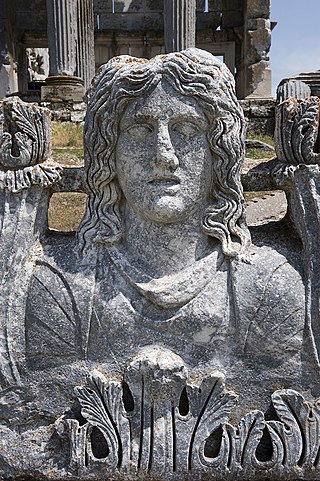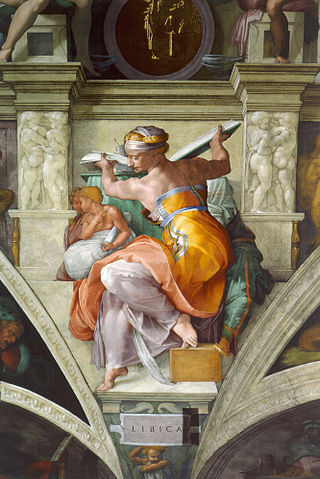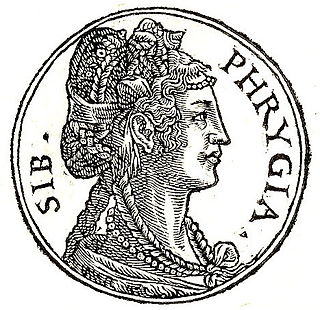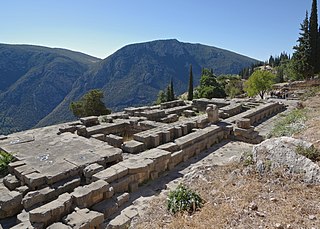
Apollo or Apollon is one of the Olympian deities in classical Greek and Roman religion and Greek and Roman mythology. Apollo has been recognized as a god of archery, music and dance, truth and prophecy, healing and diseases, the Sun and light, poetry, and more. One of the most important and complex of the Greek gods, he is the son of Zeus and Leto, and the twin brother of Artemis, goddess of the hunt. He is considered to be the most beautiful god and is represented as the ideal of the kouros. Apollo is known in Greek-influenced Etruscan mythology as Apulu.

Delphi, in legend previously called Pytho (Πυθώ), was an ancient sacred precinct and the seat of Pythia, the major oracle who was consulted about important decisions throughout the ancient classical world. The ancient Greeks considered the centre of the world to be in Delphi, marked by the stone monument known as the Omphalos of Delphi (navel).

An oracle is a person or thing considered to provide insight, wise counsel or prophetic predictions, most notably including precognition of the future, inspired by deities. If done through occultic means, it is a form of divination.

Pythia was the name of the high priestess of the Temple of Apollo at Delphi. She specifically served as its oracle and was known as the Oracle of Delphi. Her title was also historically glossed in English as the Pythoness.

Hecuba was a queen in Greek mythology, the wife of King Priam of Troy during the Trojan War.

The Corycian Cave is located in central Greece on the southern slopes of Mount Parnassus, in Parnassus National Park, which is situated north of Delphi. The Corycian Cave has been a sacred space since the Neolithic era, and its name comes from the mythological nature spirits the Corycian nymphs, which were depicted as looking like beautiful maidens and were said to inhabit the cave. More specifically it is named after the nymph Corycia; however, its name etymologically derives from korykos, "knapsack". A modern name for the cave in some references is Sarantavli, meaning "forty rooms" due to the fact that the cave has many caverns that go deep into Mt. Parnassus. The Corycian Cave was used primarily as a place of worship for the Pan, the god of the wild, as well as the Corycian nymphs, Zeus, and is also thought to be the ritual home of Dionysus. Also in mythology, Zeus was imprisoned in the Corycian Cave by the monster Typhon.

In Greek mythology, Python was the serpent, sometimes represented as a medieval-style dragon, living at the center of the Earth, believed by the ancient Greeks to be at Delphi.

The sibyls were prophetesses or oracles in Ancient Greece.

Religious practices in ancient Greece encompassed a collection of beliefs, rituals, and mythology, in the form of both popular public religion and cult practices. The application of the modern concept of "religion" to ancient cultures has been questioned as anachronistic. The ancient Greeks did not have a word for 'religion' in the modern sense. Likewise, no Greek writer known to us classifies either the gods or the cult practices into separate 'religions'. Instead, for example, Herodotus speaks of the Hellenes as having "common shrines of the gods and sacrifices, and the same kinds of customs."
"Who Mourns for Adonais?" is the second episode of the second season of the American science fiction television series Star Trek. Written by Gilbert Ralston and Gene L. Coon, and directed by Marc Daniels, it was first broadcast September 22, 1967.

The Delphic Sibyl was a woman who was a prophet associated with early religious practices in Ancient Greece and is said to have been venerated from before the Trojan Wars as an important oracle. At that time Delphi was a place of worship for Gaia, the mother goddess connected with fertility rituals that are thought to have existed throughout the ancient Mediterranean world. As needed to maintain the religious tradition, the role of sibyl would pass to another priestess at each site.

The Cimmerian Sibyl, by name Carmentis, was the prophetic priestess presiding over the Apollonian Oracle at Cimmerium in Italy, near Lake Avernus.

The Libyan Sibyl, named Phemonoe, was the prophetic priestess presiding over the Oracle of Zeus-Ammon at Siwa Oasis in the Libyan Desert.

In the extended complement of sibyls of the Gothic and Renaissance imagination, the Phrygian Sibyl was the priestess presiding over an Apollonian oracle at Phrygia, a historical kingdom in the west central part of the Anatolian highlands. She was popularly identified with Cassandra, prophetess daughter of Priam's in Homer's Iliad.

Percy Jackson & the Olympians is a series of seven fantasy novels written by American author Rick Riordan. The first book series in his Camp Half-Blood Chronicles, the novels are set in a world with the Greek gods in the 21st century. The first five books of the series follow the protagonist Percy Jackson, a young demigod who must prevent the Titans, led by Kronos (Cronus), from destroying the world.

The Temple of Apollo, also known as Apollonion, was a major part of the Panhellenic religious sanctuary located in Central Greece at Delphi. The temple and sanctuary at large were dedicated to one of the major Greek deities, Apollo, the god of archery, music, light, prophecy, the arts, and healing. There have been several temples built at Delphi throughout the history of the site, though the visible ruins seen in modernity are those of the temple built in the 4th century B.C.E. before its destruction under the orders of Theodosius I in 390 C.E.. During antiquity, the temple was home to the famous Greek prophetess the Pythia, or the Oracle of Delphi, making the Temple of Apollo and the sanctuary at Delphi a major Panhellenic religious site as early as the 8th century B.C.E., and a place of great importance at many different periods of ancient Greek history. References to Delphi, the sanctuary, the temple, and the prophecies of the Pythia are made throughout ancient Greek mythology and historical accounts from the periods of its use.

The Pig Who Saved the World (2006) is the sequel to The Pig Scrolls, both of which were written by Paul Shipton. It is set in ancient Greece and makes references to Greek mythology concerning their gods and heroes.

The Athenian Treasury at Delphi was constructed by the Athenians to house dedications and votive offerings made by their city and citizens to the sanctuary of Apollo. The entire treasury including its sculptural decoration is built of Parian marble. The date of construction is disputed, and scholarly opinions range from 510 to 480 BCE. It is located directly below the Temple of Apollo along the Sacred Way for all visitors to view the Athenian treasury on the way up to the sanctuary.

The Cumaean Sibyl was the priestess presiding over the Apollonian oracle at Cumae, a Greek colony near Naples, Italy. The word sibyl comes from the ancient Greek word sibylla, meaning prophetess. There were many sibyls throughout the ancient world. Because of the importance of the Cumaean Sibyl in the legends of early Rome as codified in Virgil's Aeneid VI, and because of her proximity to Rome, the Cumaean Sibyl became the most famous among the Romans. The Erythraean Sibyl from modern-day Turkey was famed among Greeks, as was the oldest Hellenic oracle, the Sibyl of Dodona, dating to the second millennium BC according to Herodotus, favored in the east.

Xenoclea, who appears as a character in the legend of Hercules, was the Pythia, or priestess and oracle, of the Temple of Apollo at Delphi.



















